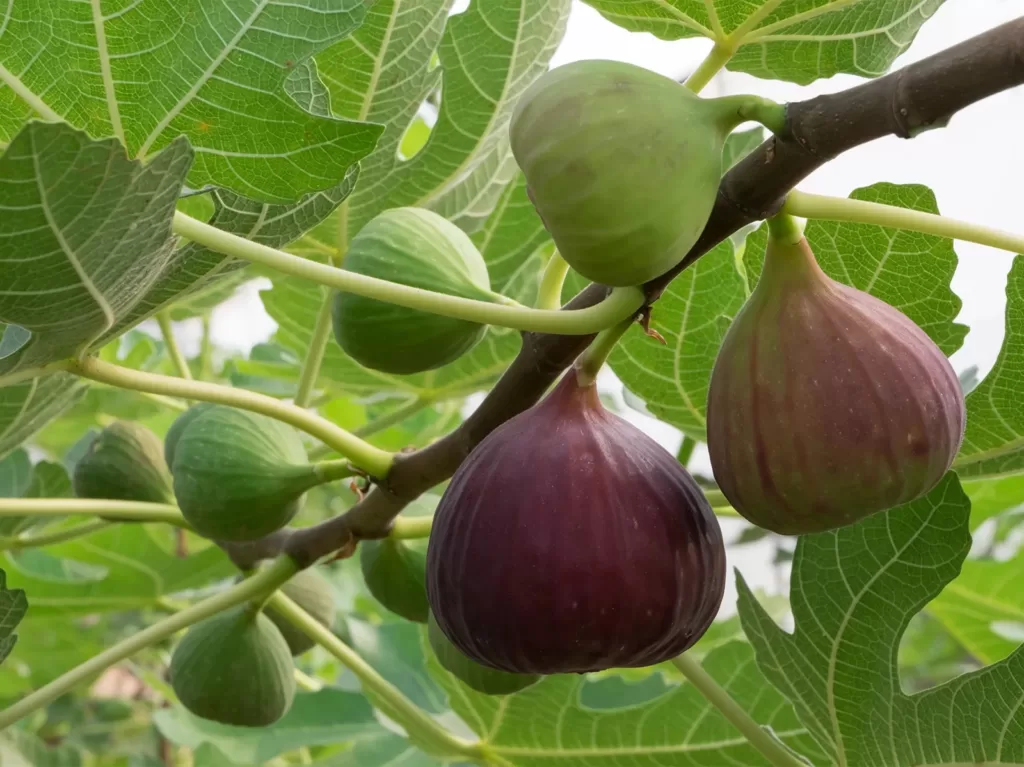Among the earliest fruit trees to be planted were fig trees. Historically, it was grown all the way from the Levant to the southern coast of the Aegean Sea. As legend has it, the people of Caria were the ones who first introduced this fruit to the ancient Greeks. Intriguingly, attic figs were especially popular in the Far East, to the point that export restrictions were put in place.
In spite of this, fig fruit was among the most nutritious foods for the Greeks, and it was served frequently at Spartan public feasts. The fig tree that grew over the heads of the pair of founders of Rome in the wolf’s cave is a symbol of the future prosperity of the Latin people, according to myth.
The nutrients found in fig fruits and their leaves may help in a number of ways. They may help with things like preventing heart disease and diabetes and keeping the digestive tract healthy. In India, it is a very famous acceptable healthy food and is commonly known as Anjeer in Hindi. Ayurveda has dealt with this fruit in detail for its numerous health benefits and as a home remedy for multiple diseases.
The article below discusses the health benefits, culinary applications, and dietary composition of figs. It also discusses how to incorporate them into your diet in a variety of ways.
Per 100 grams, fresh figs have the following nutritional value:

The nutritional value per 100 grams of fresh fig fruits is:
Energy – 74 Kcal
Dietary Fibre – 2.9 g
Carbohydrates – 19.18 g
Niacin – 0.400 mg
Total Fat – 0.30 g
Protein – 0.75 g
Folates – 6 µg
Pantothenic acid – 0.300 mg
Riboflavin – 0.050 mg
Pyridoxine – 0.113 mg
Thiamin – 0.060
Minerals:
Sodium – 1 mg
Magnesium – 17 mg
Potassium – 232 mg
Manganese – 0.128 mg
Calcium – 35 mg
Iron – 0.37 mg
Copper – 0.070 mg
Zinc – 0.15 mg
Selenium – 0.2 µg
Figs, what are they?
Ficus carica, or the common fig, is a member of the mulberry family that bears edible fruit.. Northern India and Turkey are both natural habitats for the common fig tree. Wild seedlings are present in the majority of Mediterranean countries. The fig is known as “the poor man’s food” in the Mediterranean because it is used by people all over the world, both fresh and dried.
Incorporating figs into your diet in any of the many possible ways is sure to reap the many rewards associated with eating figs. Here are the four most common ways to add figs to your diet:
# Ripe figs
Figs are a great low-cal snack option. Both in salads and sweets, they add a wonderful flavor. In addition, fresh figs can be used to make fig jams or preserves.
#Dried Figs
Calories and sugar content in dried figs are high. That’s why it’s important to limit your intake occasionally. If you suffer from constipation, however, dried figs may be more helpful than fresh figs.
#Figs leaves
Fig leaves are healthy and versatile. However, you’ll have a tough time tracking them down outside of specialty supermarkets. Fig leaves, like grape leaves, are commonly used to wrap rice, pork, and other ingredients before eating.
# Fig tea
Fig leaf tea is prepared by steeping dried fig leaves in hot water. Tea made from fig leaves can either be brewed at home or purchased already prepared from stores that specialize in such items.
The calories from fresh figs’ natural sugar are high, but you can snack on just a few without worrying about gaining weight. In contrast, dried figs are a good source of both sugar and calories. This is due to the fact that drying fruits increases their sugar content.
Dried figs, on the other hand, have a higher concentration of nutrients due to their dehydration and lower water content. However, the drying process could cause them to lose some of their nutritional value.
Benefits to Your Health From Eating Figs
Fresh fig fruits make a wonderful addition to a healthy diet due to their high nutrient density and low caloric content. Numerous bodily processes and organs benefit from it, and it is generally good for our health. Figs can aid in regulating blood sugar levels in addition to their potential effects on weight loss, skin health, and male fertility. They can also aid in promoting good digestive and cardiovascular health.
1. Initiates and Maintains Fat Loss
Figs are great as a weight loss snack because they are high in fiber and low in calories. High-fiber foods, such as figs, can aid in satiety between meals and curb binge eating when part of a healthy diet. Therefore, they may aid in speeding up the process of losing weight. Multiple studies have found that diets high in fiber can aid in weight loss.
Dried figs are more palatable and nutrient-dense after being soaked. Some claim that because fig fruits when added with water makes it rehydrated and thus more filling, it aids in weight loss by reducing overall food intake.
For those looking to trim down, eating more fruit—particularly dried fruit—may help. That’s because fruits are so nutrient-dense; they aid in weight management and general wellness. More research with actual people is needed to confirm this idea, though.

2. Diabetes and blood sugar management
Fig leaf tea is beneficial for those with type 1 diabetes. It also lowers blood sugar levels after a meal. Therefore, you can drink tea made from fig fruit leaves to help regulate your blood sugar and manage your diabetes.
Having fig leaf tea along with breakfast may have reduced insulin needs in a small 1998 study of 10 people with type 1 diabetes. Their insulin requirements dropped by about 12 percent during the month they drank fig leaf tea.
Additionally, a recent study found that beverages with high doses of fig fruit and fig leaf extract had a low glycemic index (GI) than beverages and juices with no fig fruit extract, suggesting that these beverages would have a more positive effect on blood sugar levels.
However, because of their high sugar content, fig fruits, especially dried figs, may temporarily raise blood sugar levels. Dried figs should be consumed in moderation if you struggle to control your blood sugar.
3. Improves your skin and helps you look better
Some research suggests that eating figs can have cosmetic benefits. But it is used primarily for allergic dermatitis or dry, itchy skin. Yet, dried fig fruits are effective on the skin, as shown by studies. A cream containing dried fig fruit extract was tested on 45 kids. The results from doing it twice a day for two weeks were unexpected. When comparing the effectiveness of various creams for dermatitis, the dried fig fruit cream proved to be superior to hydrocortisone cream.
Particularly for those who suffer from allergic dermatitis, or dry, itchy skin caused by allergies, figs may have some positive effects on the skin.
The standard treatment for dermatitis is hydrocortisone cream, but a recent study involving 45 children found that an ointment made from dried fig fruit extract, applied twice daily for 2 weeks, was more effective at treating dermatitis symptoms.
Another study found that the antioxidant effects of fig extracts were enhanced when combined with extracts from other fruits. Wrinkles are thereby diminished and collagen breakdown is thwarted. In addition, a combination of fruit extracts, including fig extract, was shown to have antioxidant effects on skin cells, reduce collagen breakdown, and ameliorate wrinkle appearance in vitro and in vivo.
4. It aids in male fertility and increases sperm count
Testosterone synthesis requires zinc. Therefore, low testosterone levels may be an indicator of zinc deficiency in men. On the other hand, zinc can be found in abundance in figs. So eating figs is a great way to increase your testosterone levels without any side effects.
Figs have a lot of helpful nutrients and minerals, and they’re also high in antioxidants. This means that sperm count and mobility can both increase. As a result, eating figs is a wonderful way to boost your sperm count. An increase in sperm count can be achieved by using fig leaf extracts, according to a study.
5. It has cancer-fighting potential
The impact of fig leaves on cancer cells has been the subject of numerous encouraging laboratory studies.
Researchers have discovered that human liver cancer, breast cancer, colon cancer, and cervical cancer cells are all susceptible to the antitumor effects of fig leaves and organic latex from fig plants.
It’s not clear, though, if the beneficial effects observed were caused by the fig extract or by one of the other extracts substance being tested. Studies on the effects of figs on skin health are still lacking. the effects of consuming figs or fig leave on cancer growth though not clear, but preliminary test-tube studies are encouraging.
6. Improves Digestive Health
Having difficulty passing stool is a common digestive issue. Historically, fig fruits have been used as a natural remedy for the treatment of constipation. Figs are high in fiber and good for your digestive system. Fibre acts as a prebiotic or food source for the beneficial bacteria already present in your stomach, helping to soften and thicken stools and reducing constipation, as studies have shown.
Extracts or pastes made from figs have been found to aid digestion in other research. The result is less constipation and less discomfort from gastrointestinal conditions like ulcerative colitis.
Another study found that when 150 people with IBS-C took four dried figs twice a day, their symptoms improved. Their pain, constipation, and bloating all diminished significantly. Constipation was also greatly reduced in another study where participants consumed 300 grams of fig fruit paste daily for eight weeks.
7. Strengthens Heart Health
The nutrient-rich fiber and antioxidants in figs have been shown to improve vascular health and lower cholesterol. The reason for this is that eating figs can reduce both high blood pressure and excess fat in the blood. A study found that both normal and high blood pressure mice had their blood pressure lowered by the fig extract. It has also been suggested by other research that fig leaf extracts can improve HDL cholesterol and the level of triglyceride As a result, it contributes to better heart health.
8. Helps in arthritis and has an anti-inflammatory effect
Protecting cells from free radicals and inflammation, antioxidants in figs. Also, phytochemicals are plentiful in figs. The anti-inflammatory effects of these phytochemicals are also significant.
Dried figs have been the focus of numerous scientific articles due to the many health benefits associated with their high polyphenol and flavonoid content. Anti-inflammatory and free radical-suppressing effects of these phytochemicals are well-documented. In turn, this aids in the treatment of osteoporosis, periodontal bone resorption, and rheumatoid arthritis
However, dried figs in particular are very high in sugar and may cause a temporary increase in blood sugar. Therefore, if you have problems controlling your blood sugar levels, avoiding dried figs is a good idea.
9. Fights constipation
Consuming fig fruit paste for constipation has been shown to both soften stools and not increase bowel movement frequency. Constipation can be alleviated with fig fruit paste.
Four dried figs (45 grams) twice daily were associated with a significant improvement in IBS-C symptoms like pain, constipation, and bloating, in a study involving 150 people with IBS-C and a control group.
Constipation was also significantly reduced in another study involving 80 people who took a supplement of about 10 ounces (300 grams) of fig fruit paste daily for 8 weeks.

Side Effects
Unfortunately, eating too many figs can be bad for you. Some foods, like figs, which are sometimes utilized as a possible cure for constipation, can actually cause the opposite effect and lead to diarrhea or other digestive problems.
Additionally, the vitamin K in figs can counteract the effects of blood-thinning drugs.
If you’re taking a blood thinner, you can reduce the risk of side effects by maintaining a steady diet of figs and other vitamin K-rich foods.
And lastly, fig allergies are a real thing, and they happen. It’s possible that people who are allergic to birch pollen also react negatively to figs. Some people may also be allergic to the natural latex that is present in fig trees.
You can get the health benefits of figs by eating fresh figs, dried figs, fig leaves, or consuming fig leaf tea. Due to their high sugar content, dried figs should be used sparingly.
When all is said and done
Some studies suggest that eating figs may be beneficial for your health in several ways. Not only is eating figs good for you but so does drinking a cup of tea made from fig leaves. Particularly, dried figs may be useful in easing constipation. However, vitamin K in figs may interact with blood-thinning medications, and the high sugar content of dried figs means they should be eaten in moderation.
Although dried figs can be used as a home remedy for constipation, they should be consumed sparingly due to their high sugar content. Even so, fresh fig leaves, figs, and fig leaf tea are all wonderful additions to a balanced diet.
Disclaimer: This information is for educational purposes only, and no medical advice should be inferred from it. Before changing your diet or adding supplements, please talk to your doctor.
The author’s views are his or her own. The facts and opinions in the article have been taken from various articles and commentaries available in the online media and Eastside Writers does not take any responsibility or obligation for them.
Note: Contact our Writers at www.eastsidewriters.com for writing Blogs/Articles on any niche. We have experts in various domains from Technology to Finance and from Spirituality to Lifestyle and Entertainment.






